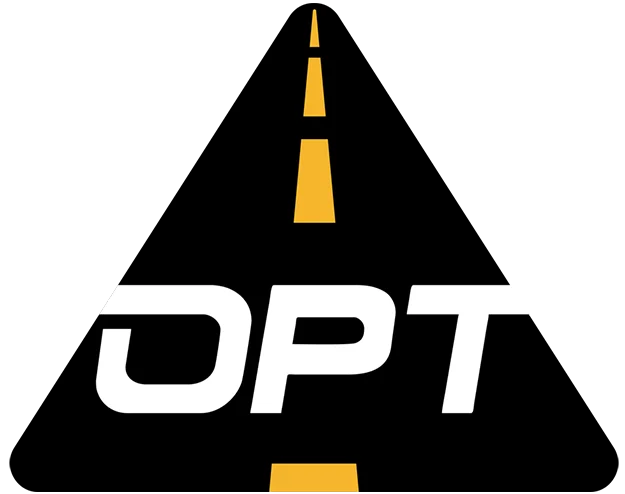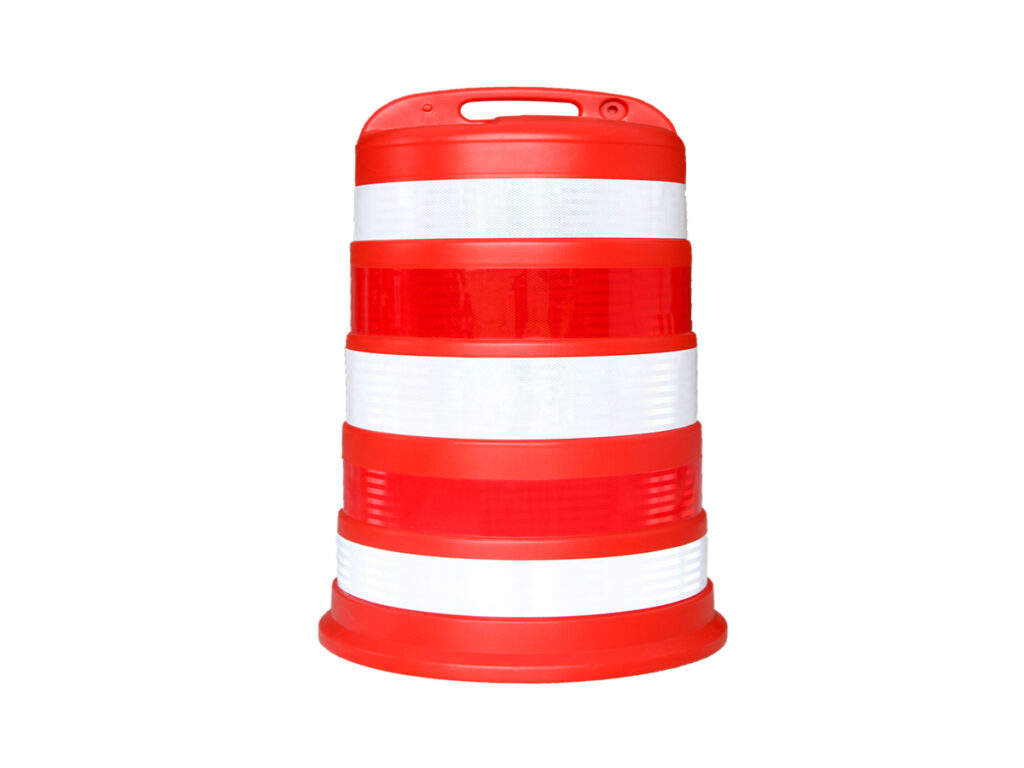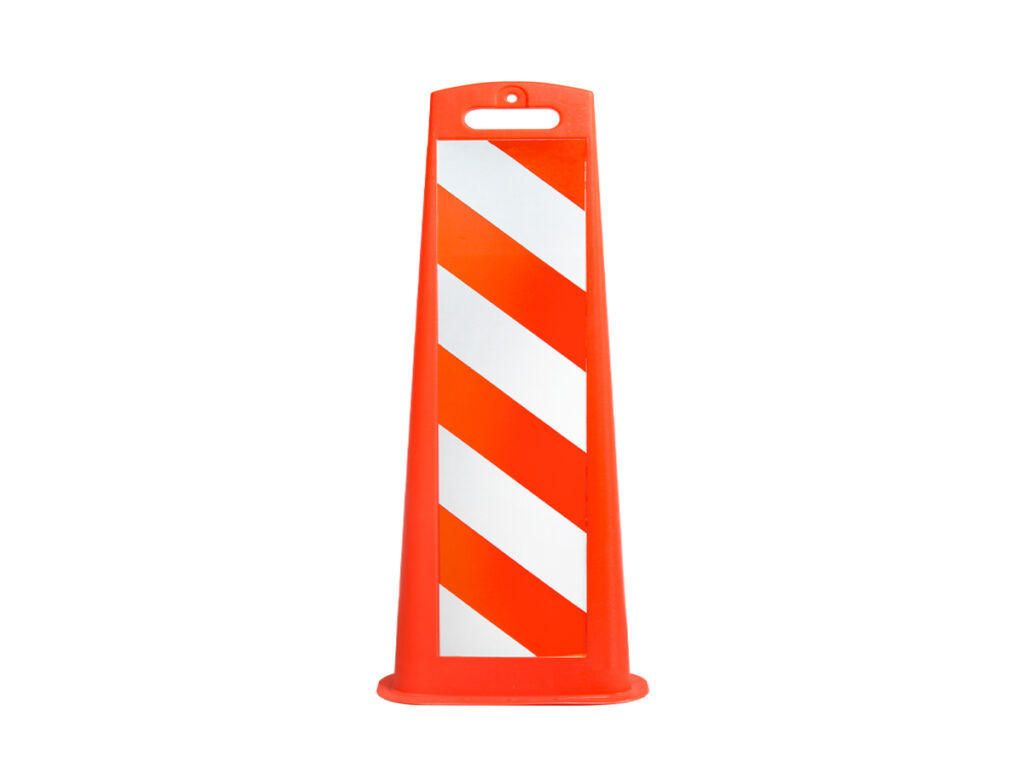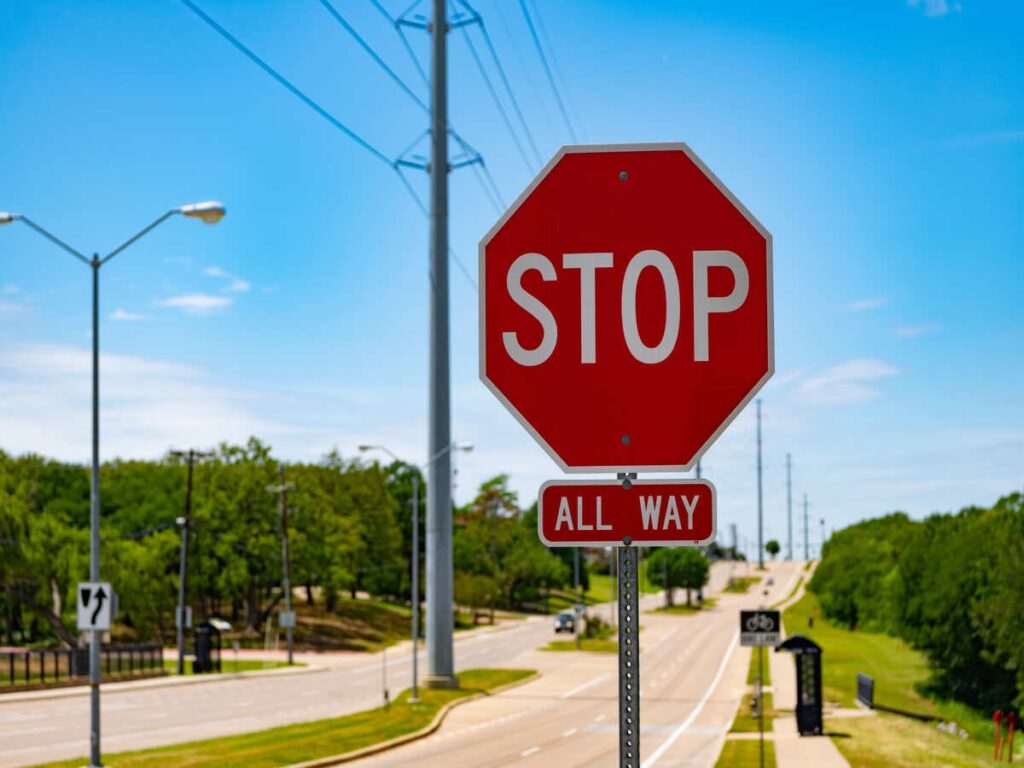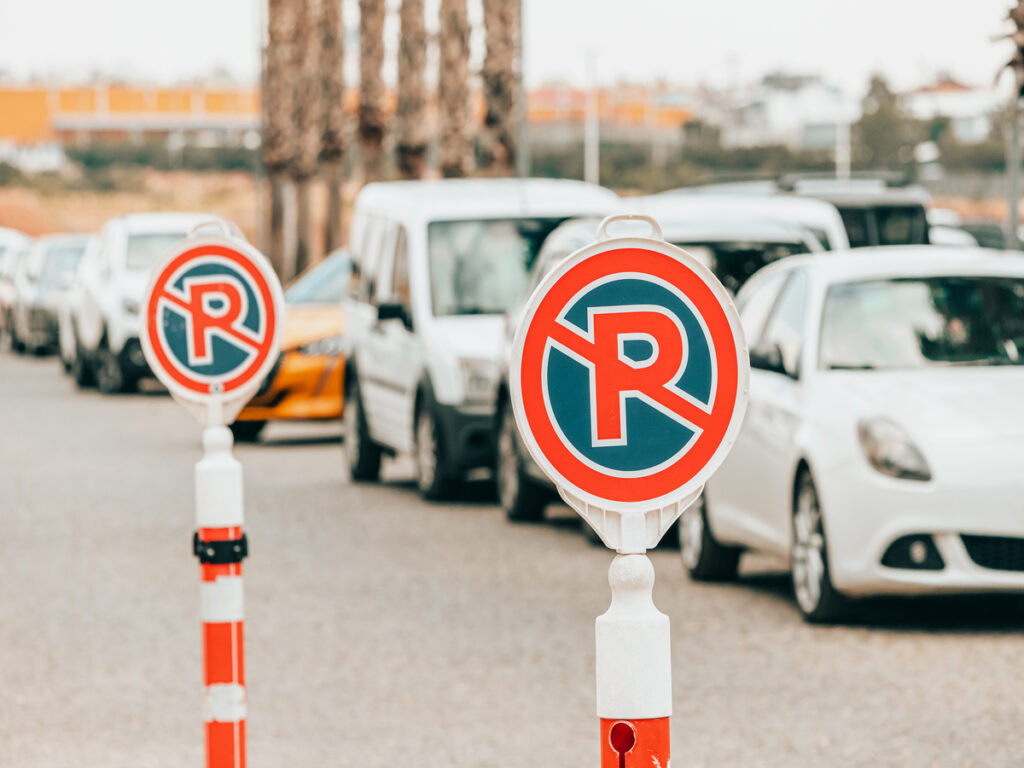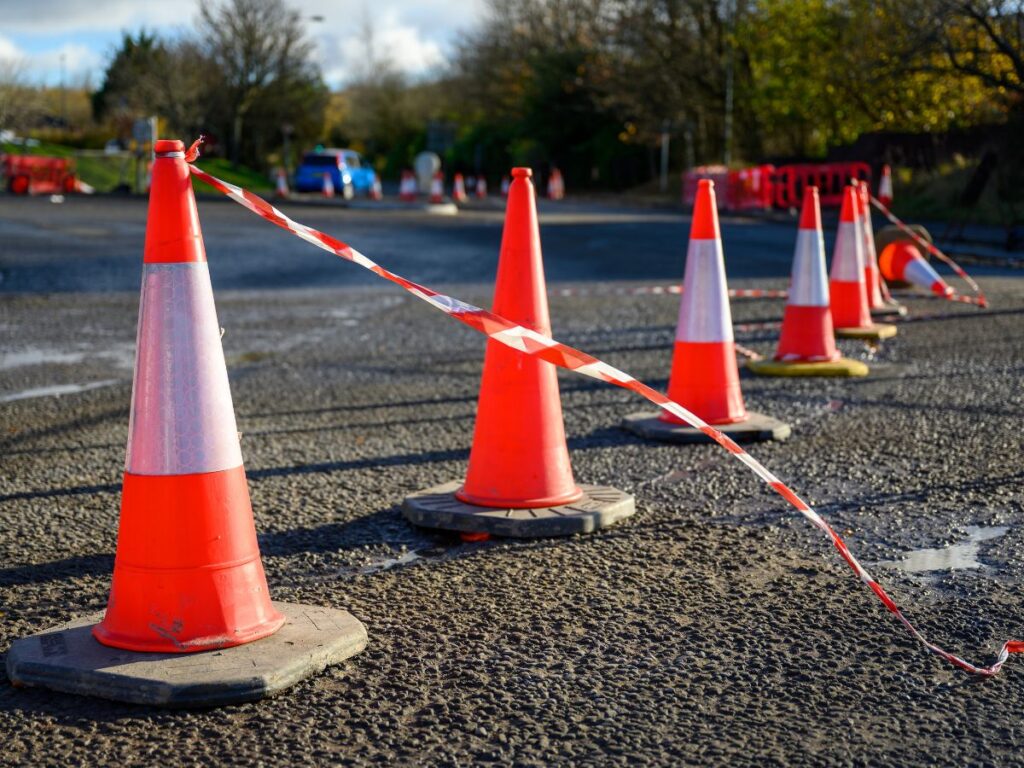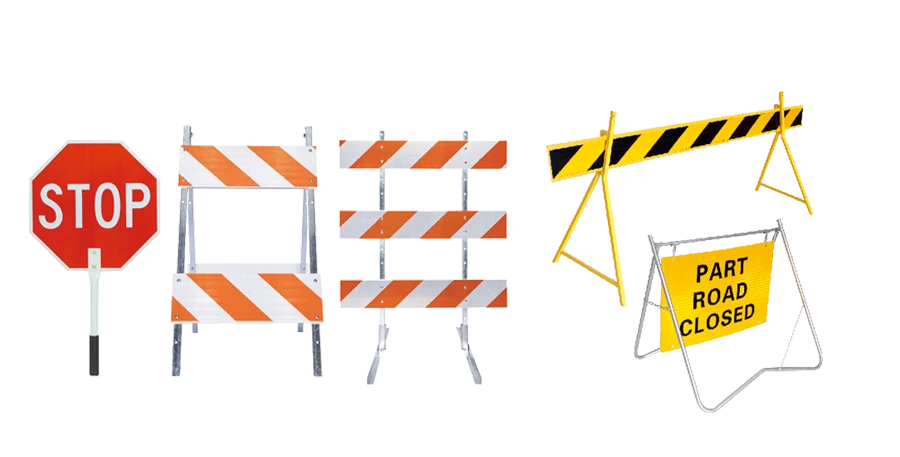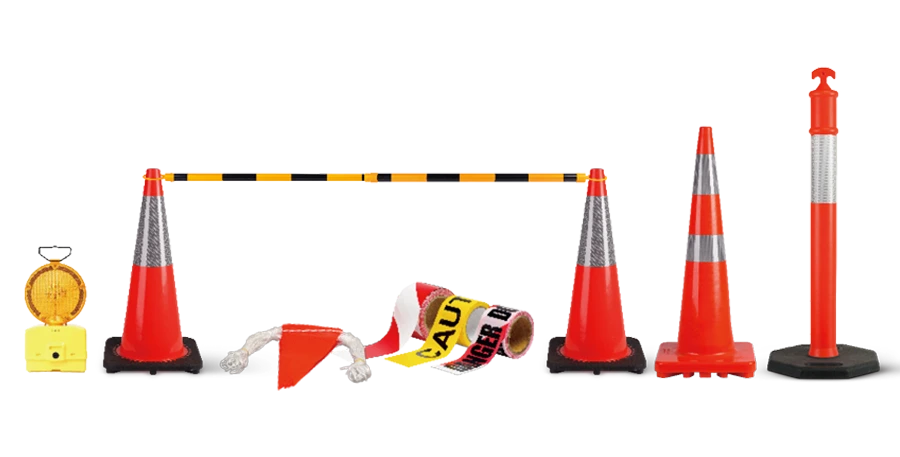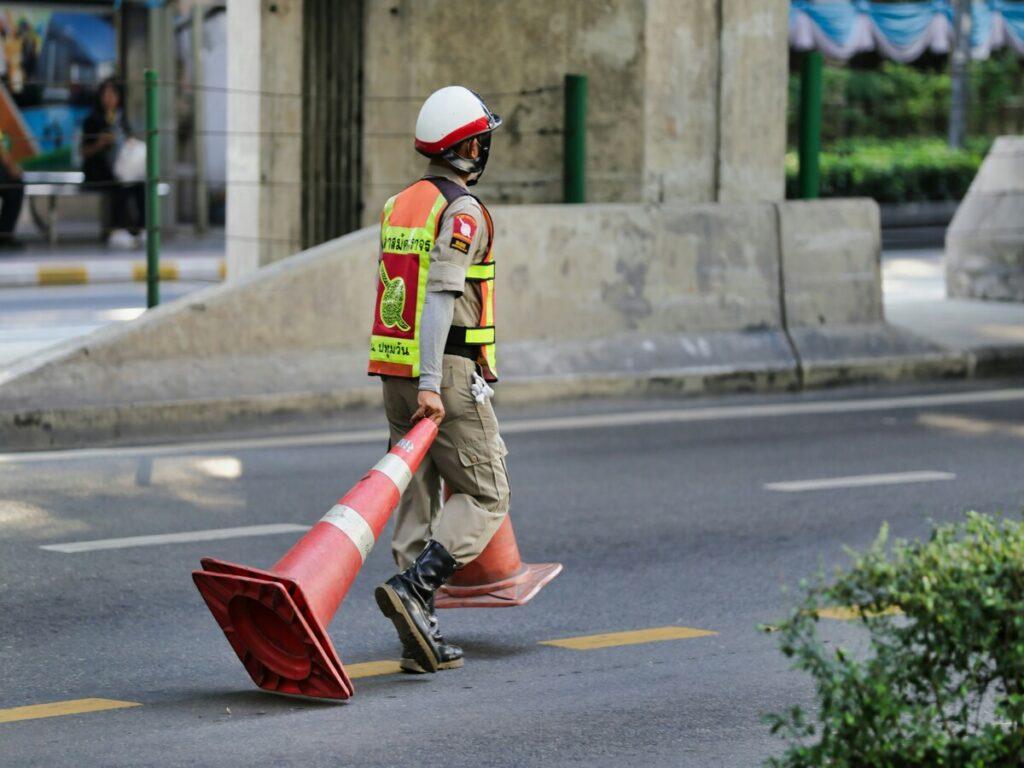
L’implementazione della linea centrale svolge un ruolo fondamentale nel mantenere le strade sicure. Ti aiuta a navigare nelle corsie, riduce la confusione, e previene gli incidenti. Separando chiaramente il traffico che si muove in direzioni opposte, le marcature della linea centrale riducono al minimo il rischio di collisioni frontali. Guidano inoltre gli automobilisti attraverso tracciati stradali complessi, Garantire il flusso di traffico più fluido.
Delineatori flessibili migliorare l’efficacia delle linee centrali. Le loro superfici riflettenti migliorano la visibilità di notte o in caso di maltempo. Colori vivaci e design flessibile li rendono strumenti affidabili per delimitare le corsie e ridurre i danni ai veicoli in caso di collisioni minori. Queste funzionalità ti aiutano a rimanere vigile e fiducioso, anche in condizioni di guida difficili.
Segni OPT offre una varietà di delineatori flessibili progettato per migliorare la sicurezza stradale e la visibilità. OPTsignifica coni stradali flessibili e i pali sono realizzati in materiale resistente, Materiali di alta qualità, garantendo marcature chiare anche in condizioni di scarsa illuminazione o condizioni meteorologiche difficili.
Importanza della distribuzione della linea centrale

Comprendere la distribuzione della linea centrale
Distribuzione centrale si riferisce al posizionamento di dispositivi di controllo del traffico o segnaletica orizzontale lungo la linea centrale di una carreggiata, in particolare nelle zone di costruzione o nelle aree che richiedono la gestione del traffico. Questo approccio aiuta a guidare i conducenti a rimanere all'interno della propria corsia, ridurre il rischio di deviazione dalla corsia e migliorare la sicurezza stradale. Le applicazioni comuni includono l'installazione di coni stradali, segni, o catarifrangenti lungo la linea centrale per definire chiaramente la divisione della strada, Migliorare la visibilità, soprattutto durante la notte o in condizioni di scarsa visibilità.
I paesi che applicano comunemente questo concetto di traffico includono gli Stati Uniti, il Regno Unito, Canada, Australia, e varie nazioni europee, in particolare in zone con elevati volumi di traffico o con tracciati stradali complessi.
Prevenire le collisioni frontali
Le marcature della linea centrale svolgono un ruolo fondamentale nel ridurre le collisioni frontali. Questi incidenti si verificano spesso quando i conducenti si immergono involontariamente nel traffico in arrivo. Una linea centrale chiara funge da barriera visiva, aiutandoti a rimanere nella tua corsia. Questa misura semplice ma efficace riduce significativamente il rischio di incidenti gravi. Su strade tortuose o aree con curve strette, le linee centrali forniscono una guida essenziale, soprattutto quando la visibilità è limitata. Seguendo queste indicazioni, puoi navigare in sicurezza ed evitare situazioni pericolose.
Migliorare il flusso del traffico
Un flusso di traffico efficiente dipende dalla chiara separazione delle corsie. Le linee centrali ti aiutano a capire dove dovrebbe essere il tuo veicolo, anche durante il traffico intenso. Riducono la confusione definendo chiaramente le corsie per le direzioni opposte. Questa organizzazione riduce al minimo i cambi di corsia improvvisi e le fermate inutili, che può portare alla congestione. SU strade a più corsie, le linee centrali aiutano anche a mantenere la corretta spaziatura tra i veicoli. Quando il traffico scorre liscio, il tempo di viaggio diminuisce, e l'esperienza di guida complessiva migliora.
Miglioramento della sicurezza in condizioni di scarsa visibilità
Guidare di notte o in caso di nebbia può essere impegnativo. La scarsa visibilità aumenta la probabilità di incidenti. Contrassegni della linea centrale, soprattutto quelli arricchiti con materiali riflettenti, migliorare la tua capacità di vedere la strada. Ti guidano in sicurezza, anche quando la luce naturale è insufficiente.
Uno studio sui tassi di incidenti evidenzia l’importanza delle linee centrali in condizioni di scarsa visibilità. Strade con una larghezza della pavimentazione di 22 i piedi hanno visto a 52% riduzione degli incidenti notturni quando erano presenti le linee centrali. Strade più strette, come quelli 18 piedi larghi, sperimentato a 46% diminuzione in condizioni simili.
| Larghezza pavimentazione | Riduzione dei tassi di incidenti notturni | Riduzione degli incidenti notturni con scarsa visibilità |
|---|---|---|
| 22 piedi | 36% | 52% |
| 20 piedi | 13% | 23% |
| 18 piedi o meno | N / A | 46% |
Queste statistiche dimostrano come le linee centrali migliorino la sicurezza fornendo chiari segnali visivi. Quando fai affidamento su questi segni, riduci il rischio di incidenti e ti garantisci un viaggio più sicuro.
Regolamenti e standard
Linee guida chiave per la segnaletica della linea centrale
Standard MUTCD
IL Manuale sui dispositivi di controllo del traffico uniforme (MUTCD) pone le basi per la segnaletica della linea centrale negli Stati Uniti. Questi standard garantiscono che la segnaletica stradale sia coerente e facile da comprendere. MUTCD specifica il colore, larghezza, e posizionamento delle linee centrali. Per esempio:
- Linee gialle traffico separato che si muove in direzioni opposte.
- Linee bianche indicano le corsie che si muovono nella stessa direzione.
- Le linee spezzate consentono il passaggio, mentre le linee continue lo limitano.
Seguendo queste linee guida, le autorità stradali creano segnaletica orizzontale prevedibile e affidabile per gli automobilisti come te.
Regolamenti locali e statali
Mentre MUTCD fornisce standard nazionali, i governi locali e statali spesso aggiungono regole specifiche. Queste normative riguardano le condizioni stradali uniche nella tua zona. Ad esempio, alcuni stati richiedono vernice riflettente per una migliore visibilità notturna. Altri potrebbero imporre linee più ampie sulle strade rurali per migliorare la sicurezza. Rimanere informato su queste regole locali ti aiuta a capire come la segnaletica si adatta ai diversi ambienti.
Importanza della conformità
Garantire gli standard legali e di sicurezza
Il rispetto delle normative garantisce che le strade soddisfino i requisiti legali e di sicurezza. Quando le autorità seguono questi standard, trarrai vantaggio da indicazioni chiare ed efficaci. La non conformità può creare confusione, incidenti, e anche conseguenze legali. Le strade adeguatamente segnalate riducono i rischi e rendono il viaggio più sicuro.
Promuovere l’uniformità sulle strade
L'uniformità della segnaletica orizzontale ti aiuta a guidare con sicurezza. Quando le marcature appaiono e funzionano allo stesso modo ovunque, sai cosa aspettarti. Questa coerenza riduce gli errori e migliora il flusso del traffico. Sia che tu stia guidando nella tua città natale o visitando un altro stato, le marcature uniformi ti guidano in modo efficace.
Mancia: Prestare sempre attenzione alla segnaletica stradale. Sono progettati per mantenerti sicuro e informato, Non importa dove guidi.
Migliori pratiche per la distribuzione della linea centrale
Strade urbane
Gestione della sicurezza del traffico intenso e dei pedoni
Le strade urbane sono spesso caratterizzate da elevati volumi di traffico e da una significativa attività pedonale. Una corretta distribuzione della linea centrale garantisce sicurezza e un flusso di traffico regolare in queste aree trafficate. Installazione delle linee centrali, linee di bordo, e i delineatori flessibili possono ridurre fino a 45%. Questi segnali aiutano i conducenti a rimanere nella propria corsia e forniscono indicazioni chiare per spostarsi agli incroci e alle strisce pedonali.
Nelle zone con frequenti incidenti, l'aggiunta di linee centrali e linee di bordo può ridurre i tassi di incidente 14%. I delineatori flessibili migliorano queste marcature migliorando la visibilità e la durata, Soprattutto nelle zone ad alto traffico. Le loro superfici riflettenti li rendono efficaci durante la notte o in condizioni meteorologiche avverse. Combinando questi strumenti, puoi creare ambienti urbani più sicuri sia per i conducenti che per i pedoni.
Autostrade
Garantire visibilità e durata
Le autostrade richiedono segnaletica orizzontale che resista al traffico intenso e alle condizioni meteorologiche estreme. Materiali durevoli, come vernice termoplastica o nastro riflettente, garantire che le marcature restino visibili nel tempo. I delineatori flessibili svolgono un ruolo cruciale qui. Forniscono indicazioni aggiuntive, soprattutto in aree con curve strette o zone di costruzione.
Sulle autostrade, la visibilità è fondamentale per prevenire gli incidenti. I delineatori riflettenti migliorano la sicurezza notturna rendendo le linee centrali più evidenti. Questi strumenti aiutano inoltre i conducenti a mantenere la corretta disciplina della corsia ad alta velocità. Dando priorità alla durabilità e alla visibilità, puoi migliorare la sicurezza e ridurre i costi di manutenzione sulle autostrade.
Strade rurali
Affrontare strade strette e condizioni di scarsa illuminazione
Le strade rurali spesso presentano sfide uniche, come larghezze strette e bassi volumi di traffico. Il MUTCD consiglia di utilizzare il giudizio ingegneristico per le strade inferiori a 16 piedi larghi. In alcuni casi, misure alternative come i delineatori di post o i segnali di avvertimento delle curve possono essere più efficaci delle tradizionali linee centrali.
Le condizioni di scarsa illuminazione sulle strade rurali aumentano il rischio di incidenti. Le linee centrali riflettenti e i delineatori flessibili migliorano la visibilità, Aiutarti a navigare in sicurezza. Questi strumenti sono particolarmente utili su strade tortuose o aree con illuminazione limitata. Affrontando queste sfide, puoi migliorare la sicurezza e ridurre il tasso di incidenti nelle zone rurali.
Tipi di delineato di traffico
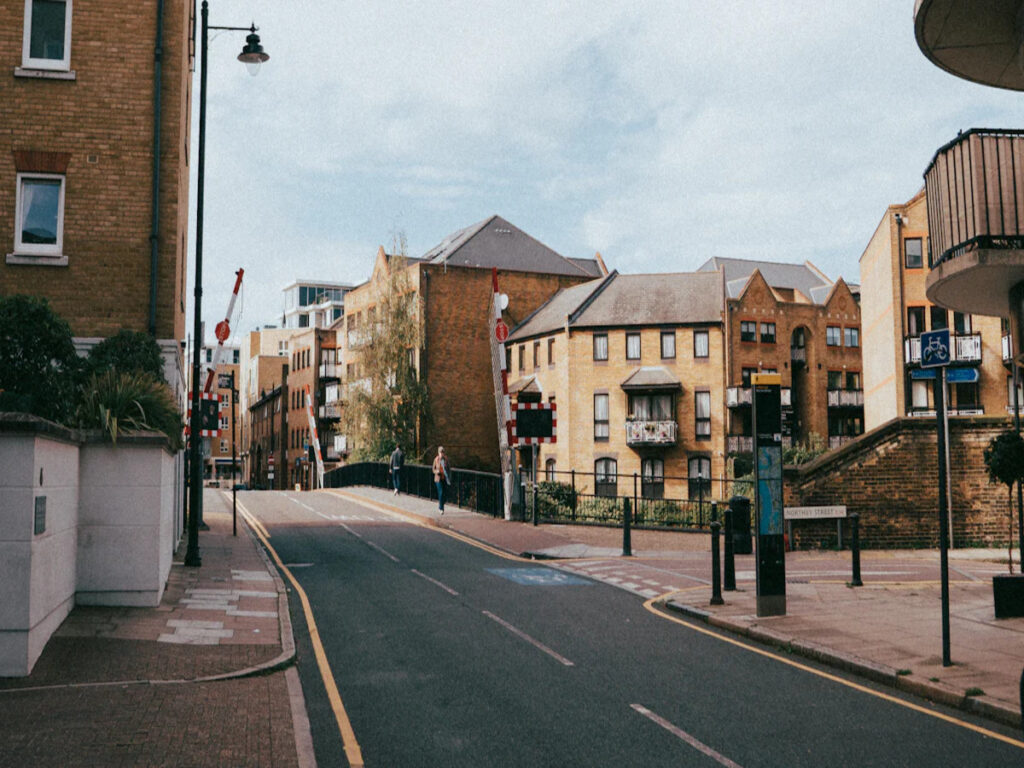
Coni stradali
Applicazioni per zone temporanee e di costruzione
I coni stradali sono tra i delineatori di traffico più riconoscibili. Li vedi spesso nelle zone di costruzione o durante le chiusure temporanee delle strade. Il loro colore arancione brillante e le bande riflettenti li rendono altamente visibili, anche in condizioni di scarsa illuminazione. Questi coni guidano i veicoli in sicurezza attorno ai pericoli, Garantire un flusso di traffico regolare.
Nelle zone di costruzione, i coni aiutano a reindirizzare il traffico lontano dai lavoratori e dalle attrezzature. Segnalano anche corsie o deviazioni temporanee, Ridurre la confusione per i driver. Per esempio, i coni canalizzatori sono progettati specificatamente per guidare i veicoli attraverso le aree di manutenzione. Il loro design leggero consente una rapida installazione e rimozione, rendendoli ideali per l'uso a breve termine.
Mancia: Rallentare sempre e seguire il percorso segnalato dai coni stradali nelle zone di lavoro. Ciò mantiene te e gli altri al sicuro.
Tamburi di controllo del traffico
Soluzioni durevoli per aree ad alto traffico
Tamburi per il controllo del traffico fornire una soluzione più duratura per le aree ad alto traffico. Questi grandi, barrel-shaped delineators are designed to withstand impacts and remain stable in harsh conditions. You’ll often find them in construction zones or along highways where safety is critical.
Safety drums are highly visible due to their bright colors and reflective stripes. They are particularly effective in high-risk areas, such as lane closures or roadwork zones. A differenza dei coni, drums offer greater stability, making them suitable for long-term projects.
Basta a T-top are also used to separate lanes in busy areas. Their sturdy design ensures they stay in place, even in heavy traffic.
Indicatori riflettenti
Enhancing Night-Time Visibility
Reflective markers play a crucial role in improving night-time visibility. These small devices reflect headlights, making lane markings, curve, and road edges more noticeable. You’ll find them on poorly lit roads, curve affilate, o aree soggette a nebbia.
Gli indicatori riflettenti migliorano la consapevolezza del conducente, riducendo il rischio di incidenti in condizioni di scarsa illuminazione. Ad esempio, I delineatori di cubi d'angolo migliorano la visibilità nei tracciati stradali complessi. Le strade dotate di questi contrassegni subiscono meno incidenti rispetto a quelle che ne sono prive. Ciò dimostra la loro efficacia nel guidare i conducenti in sicurezza attraverso ambienti difficili.
| Descrizione dell'evidenza | Impatto sulla sicurezza |
|---|---|
| Gli indicatori riflettenti riflettono i fari, migliorare la visibilità della segnaletica orizzontale, curve, e bordi stradali. | Migliora la consapevolezza del conducente in condizioni di scarsa illuminazione, riducendo gli incidenti. |
| I catarifrangenti sono fondamentali sulle strade poco illuminate e in caso di maltempo. | Guida gli autisti in modo efficace, ridurre al minimo i rischi. |
| Le strade con catarifrangenti hanno meno incidenti rispetto a quelle senza. | Dimostra l'efficacia dei riflettori nella riduzione degli incidenti. |
I delineatori flessibili possono integrare i segnalatori riflettenti fornendo indicazioni aggiuntive in aree con traffico intenso o scarsa visibilità. La loro versatilità li rende uno strumento prezioso per migliorare la sicurezza stradale.
Pannelli verticali
Applicazioni ad alta velocità e alta visibilità
Pannelli verticali sono essenziali per le strade ad alta velocità dove la visibilità e la sicurezza sono fondamentali. Questi pannelli sono alti e presentano colori vivaci con superfici riflettenti, rendendoli facili da individuare anche di notte o in condizioni meteorologiche avverse. Li vedi spesso sulle autostrade, zone di costruzione, o aree con chiusure di corsie. Il loro design garantisce che rimangano stabili ed efficaci nel guidare il traffico attraverso aree ad alto rischio.
A differenza di altri delineatori, i pannelli verticali eccellono negli ambienti ad alta velocità. Il loro profilo sottile riduce al minimo la resistenza al vento, consentendo loro di rimanere in posizione verticale anche in condizioni difficili. Ciò li rende ideali per le aree soggette a forti venti o al movimento di veicoli pesanti. Le strisce riflettenti su questi pannelli migliorano la visibilità, aiutare i conducenti a mantenere la corretta disciplina della corsia ad alta velocità.
Mancia: Prestare sempre attenzione ai pannelli verticali durante la guida in autostrada. Forniscono una guida fondamentale e ti aiutano a navigare in sicurezza attraverso zone di costruzione o cambi di corsia.
Delineatori flessibili
Soluzioni versatili per varie condizioni stradali
I delineatori flessibili offrono una versatilità senza pari, rendendoli adatti ad un'ampia gamma di condizioni stradali. Questi delineatori sono progettati per resistere agli urti e tornare nella loro posizione originale, Garantire la durata e l'affidabilità. Sia che tu stia guidando su strade urbane, autostrade, o aree rurali, i delineatori flessibili forniscono una guida visiva chiara e migliorano la sicurezza.
La loro capacità di assorbire gli impatti li rende ideali per zone ad alto traffico o aree con veicoli pesanti. Per esempio, i pali flessibili possono sopportare impatti ripetuti senza rompersi, mentre i pali di avvertimento flessibili realizzati in polietilene ritornano in posizione verticale dopo essere stati colpiti. Questa funzionalità riduce i costi di manutenzione e garantisce la funzionalità continua.
| Tipo di delineatore | Vantaggi |
|---|---|
| Posta flessibile | Resiste all'impatto del traffico elevato, adatto alla circolazione di mezzi pesanti. |
| Post di avvertimento Flexy | Realizzato in polietilene, ritorna in posizione verticale dopo l'impatto, migliora la visibilità. |
| Post di avvertimento | Assorbe l'impatto, riduce al minimo i rischi di lesioni, rimane visibile in condizioni difficili. |
| Post Poly Flex | Combina durata e flessibilità, design resistente agli urti. |
| Delineatori generali | Agisce come barriere visive, fornisce indicazioni nelle aree ad alto rischio, superfici riflettenti per visibilità in condizioni di scarsa illuminazione. |
I delineatori flessibili migliorano anche la sicurezza in condizioni di scarsa illuminazione. Le loro superfici riflettenti li rendono visibili di notte o in caso di maltempo, Aiutandoti a rimanere in rotta. Queste caratteristiche rendono i delineatori flessibili una scelta affidabile per migliorare la sicurezza stradale in vari ambienti.
Scegliere il delineatore giusto
Fattori chiave
Volume di traffico e tipo di strada
Quando si selezionano i delineatori di traffico, devi considerare il tipo di strada e il volume di traffico che gestisce. Aree ad alto traffico, come autostrade, richiedono delineatori durevoli in grado di resistere a impatti frequenti. I delineatori flessibili sono ideali per queste condizioni perché ritornano nella loro posizione originale dopo essere stati colpiti. Su strade urbane, dove la velocità del traffico varia, i delineatori con superfici riflettenti migliorano la visibilità e guidano i conducenti in modo efficace. Per strade rurali, la durata e la visibilità rimangono essenziali, soprattutto in zone con vicoli stretti o curve strette.
Condizioni ambientali
I fattori ambientali svolgono un ruolo significativo nella scelta del delineatore giusto. I delineatori riflettenti migliorano la visibilità all'interno condizioni di scarsa illuminazione o nebbia, garantendo una navigazione più sicura per i conducenti. Nelle regioni con clima rigido, materiali come il polietilene o il policarbonato garantiscono prestazioni di lunga durata. I delineatori ad energia solare sono particolarmente utili nelle zone di costruzione, offrendo una migliore visibilità durante la notte o in condizioni meteorologiche avverse. Considerando queste condizioni, è possibile selezionare delineatori che mantengano la loro efficacia nel tempo.
Tecnologia e Innovazione
Sistemi di traffico intelligenti
Sensori e automazione
I sistemi di traffico intelligenti stanno trasformando il modo in cui funzionano le strade. I sensori integrati nelle strade e nei veicoli raccolgono dati per monitorare il flusso del traffico. Questi sensori rilevano la congestione, incidenti, e modelli insoliti, consentendo alle autorità di rispondere rapidamente. L’automazione gioca un ruolo chiave nella gestione dei segnali stradali e nell’utilizzo delle corsie. Adaptive traffic lights adjust their timing based on real-time conditions, reducing delays and improving efficiency.
Per esempio, automated systems can reroute vehicles during peak hours or emergencies. This reduces bottlenecks and ensures smoother traffic movement. By relying on these technologies, you experience safer and more efficient travel.
Real-Time Traffic Data
Real-time traffic data enhances your driving experience by providing up-to-the-minute updates. Smart systems analyze this data to predict traffic patterns and identify potential hazards. You can access this information through navigation apps or digital road signs.
These systems also improve safety by alerting you to accidents, chiusure stradali, or severe weather conditions. With this knowledge, you can make informed decisions, such as choosing alternate routes or adjusting your speed. I dati in tempo reale ti garantiscono di rimanere preparato ed evitare rischi inutili.
Tendenze future
Materiali avanzati e soluzioni AI
Il futuro della sicurezza stradale risiede nei materiali avanzati e Soluzioni basate sull'intelligenza artificiale. Le innovazioni nei delineatori del traffico includono l'uso di materiali ecologici e riciclati. Queste opzioni sostenibili sono in linea con le crescenti preoccupazioni ambientali e con politiche più rigorose.
Le soluzioni di intelligenza artificiale stanno rivoluzionando anche la gestione del traffico. Ecco come:
- Monitoraggio del traffico in tempo reale: L’intelligenza artificiale analizza il flusso del traffico per rilevare congestioni o incidenti.
- Sistemi di rilevamento ed prevenzione delle collisioni: L’intelligenza artificiale nei veicoli identifica i pericoli e fornisce avvisi.
- IoT e AI per infrastrutture intelligenti: I sistemi intelligenti si adattano alle condizioni in tempo reale per una migliore gestione del traffico.
- Manutenzione predittiva: L’intelligenza artificiale prevede i guasti alle apparecchiature, riducendo i costi e prevenendo i guasti.
Questi progressi creano più sicurezza, strade più sostenibili per te e per le generazioni future.
Rafforzamento della linea centrale per la moderazione del traffico
L’irrigidimento della linea centrale è una strategia efficace per la moderazione del traffico urbano. Implica il rafforzamento delle linee centrali per guidare i veicoli e ridurre le manovre rischiose. Questo approccio rallenta i veicoli che svoltano a sinistra, migliorare la sicurezza dei pedoni e degli altri conducenti.
Le linee centrali rinforzate migliorano inoltre la visibilità agli incroci, aiutandoti a individuare i pedoni più facilmente. Prevenendo virate ampie ad alta velocità, riducono la probabilità di incidenti. Queste misure rendono le strade urbane più sicure e più prevedibili per tutti.
Mancia: Stai attento alle nuove tecnologie e alla progettazione stradale. Sono progettati per rendere il tuo viaggio più sicuro ed efficiente.
La distribuzione della linea centrale e i delineatori del traffico sono essenziali per strade più sicure. Ti guidano attraverso le corsie, ridurre gli incidenti, e migliorare il flusso del traffico. I delineatori flessibili si rivelano uno strumento chiave per migliorare la sicurezza stradale.
- Migliorano la visibilità in condizioni di scarsa illuminazione.
- Il loro posizionamento in aree ad alto rischio previene incidenti e deviazioni dalla corsia.
- Proteggono i pedoni creando confini chiari.
L’adozione di soluzioni di traffico innovative può migliorare ulteriormente la sicurezza. Per esempio:
| Strategia | Benefici |
|---|---|
| Realizzazione di piste ciclabili e pedonali | Incoraggia il trasporto attivo e migliora la sicurezza. |
| Potenziare i trasporti pubblici | Fornisce alternative convenienti, riduzione della congestione stradale. |
| Prezzi di congestione | Regolamenta l'utilizzo del veicolo nelle ore di punta, miglioramento della qualità dell’aria. |
Abbracciando queste strategie e strumenti, contribuisci a essere più sicuro, strade più efficienti per tutti.
